
Synodontis is the largest genus of mochokid catfishes. It is the biggest genus within the 10 genera and 190 different species in the family Mochokidae. Synodontis has over 131 different species within the genus. Synodontis are also known as squeakers, due to their ability to make stridulatory sounds through their pectoral fin spines when handled or disturbed. Synodontis make a sound that sounds like squeaking by rubbing their spines together. They do this when they have been frightened or when they become angry. Synodontis may also squeak when they are taken out of the water. These catfish are small- to medium-sized fish with many species exhibiting attractive spotted markings. Some species are also known for naturally swimming belly-up, earning the name upside-down catfish. Some of these species are Synodontis contractus and Synodontis nigriventris. While some of these species are known to swim upside down, another species, Synodontis multipunctatus, is a brood parasitic cuckoo catfish,there are two other species Synodontis petricola and Synodontis grandiops are also called brood parasitic cuckoo catfish.
The Andean catfish is a species of freshwater fish in the family Astroblepidae. The Spanish name for the Andean catfish is preñadilla. It is endemic to the highlands of the Ecuadorian Andes where it lives in mountain streams in four different drainage basins in the Imbakucha watershed. It is a brownish-grey fish growing to about 150 mm (6 in). The fish is threatened by human activities in the area with loss and fragmentation of its habitat, and the International Union for Conservation of Nature has assessed its conservation status as being "critically endangered".
Notoglanidium depierrei is a species of catfish family Claroteidae. This species is endemic to Cameroon where it is known only from its type locality of the Sanaga River Basin. It reaches a length of about 17.2 centimetres (6.8 in) SL. It was formerly considered to be the sole member of the monotypic genus Platyglanis but this has now been synonymised with Notoglanidium.

Auchenoglanis is a genus of relatively large, up to 70 cm (2.3 ft) SL, claroteid catfishes native to various freshwater habitats in Africa.
Jacques Pellegrin was a French zoologist.
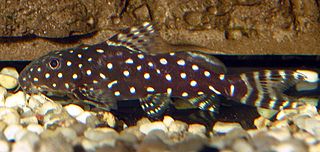
Synodontis angelicus is a species of upside-down catfish commonly named polkadot squeaker, black clown catfish, whitespotted squeaker, pearl squeaker, or angel squeaker. This species is native to the Congo Basin in the Democratic Republic of the Congo and the Republic of the Congo. It was originally described in 1891 by Belgian ichthyologist Louise Schilthuis after its discovery in the Malebo Pool of the Congo River. The specific name "angelicus" means heavenly or divine, since juveniles of this species are remarkable for their bright coloring.
Notoglanidium akiri is a species of claroteid catfish endemic to Nigeria where it occurs in the Niger Delta and the New Calabar and Bonny Rivers. It reaches a length of 10.7 cm SL.
Notoglanidium boutchangai is a species of claroteid catfish.
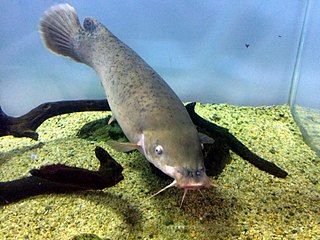
Malapterurus microstoma, the smallmouth electric catfish, is a species of electric catfish native to the Congo River basin of Central African Republic, the Democratic Republic of the Congo and the Republic of the Congo. This species grows to a length of 55.5 centimetres (21.9 in) SL. This fish can be found in the aquarium trade. It is illegal to possess any species of electric catfish for personal or commercial use in Florida.
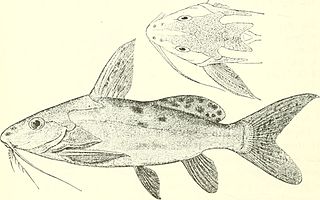
Synodontis haugi, known as the black synodontis, is a species of upside-down catfish native to Gabon where it is found in the Ogowe River basin. It was first collected by M.E. Haug and described by French zoologist Jacques Pellegrin in 1906, based upon a holotype discovered in the Ogooué River, near Ngomo, Gabon. The specific name "huagi" is a tribute to the original collector of the species.
Synodontis longispinis is a species of upside-down catfish that is endemic to the Republic of the Congo where it is found in the Sangha River. It was first described by Jacques Pellegrin in 1930 as Synodontis batesi longspinis, a subspecies of S. batesi with an especially long dorsal fin spine, but it is presently recognized as its own species. The species name longispinis is derived from the word longus, meaning long, and the word spinis, meaning spine, which is a reference to the long dorsal fin spine on the fish.
Synodontis macrostoma, known as the largemouth squeaker, is a species of upside-down catfish that is native to Namibia and Zambia where it is found in the Kafue, upper Zambezi, Okavango and Cunene Rivers. It was first described by Paul H. Skelton and Peter N. White in 1990. The original specimens were obtained in Upper Zambezi River at Katima Mulilo, Caprivi, Namibia. The species name macrostoma means "large mouth", which refers to its distinctive large mouth.
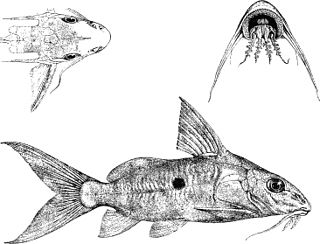
Synodontis nummifer, known as the two spot synodontis, is a species of upside-down catfish native to the Congo Basin of Cameroon, the Democratic Republic of the Congo and the Republic of the Congo. It was first described by the Belgian-British zoologist George Albert Boulenger in 1899, based upon a holotype discovered in Léopoldville, Belgian Congo. The specific name "nummifer" comes from the Latin for "to bear a coin", which refers to the large spots on its sides.
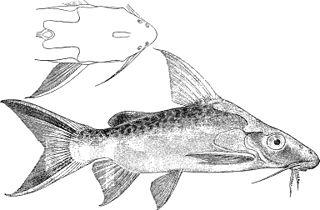
Synodontis pleurops, known as the Congo squeaker, the bigeye squeaker, or the bug eyed synodontis, is a species of upside-down catfish native to the upper Congo Basin of Cameroon, the Democratic Republic of the Congo and the Republic of the Congo. It was first described by the Belgian-British zoologist George Albert Boulenger in 1899, based upon a holotype discovered at the Boyoma Falls, in the Democratic Republic of the Congo.

Pareutropius debauwi is a species that belong to the Order Actinopterygii, ray-finned fishes, and can be placed in the Schilbeidae family, Schilbid catfishes. This family includes 9 genera and 46 species. The common name for Pareutropius debauwi is the African glass catfish.
Lamprologus lethops is a species of cichlid fish from areas with fast current in the Congo River in Central Africa, where it is believed to live in depths as great as 160 m (520 ft) or 200 m (660 ft) below the surface. It reaches up to about 12.5 cm (5 in) in standard length, with females being somewhat smaller than males, is all whitish in color (non-pigmented), and essentially blind as adult, as their eyes are covered in a thick layer of skin. This is entirely unique among cichlids and an adaption to the perpetual darkness of its habitat, similar to the adaptions seen in cavefish. The eyes of juveniles are rudimentary and not covered by skin.
Chrysichthys depressus is a species of catfish endemic to the Democratic Republic of the Congo where it is only found near Boma. It was formerly known as Gnathobagrus depressus.

Notoglanidium is a genus of claroteid catfishes native to Africa. The formerly recognized genera Anaspidoglanis, Liauchenoglanis and Platyglanis have all been merged into Notoglanidium.
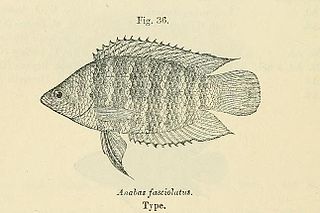
Microctenopoma fasciolatum or the banded bushfish is an Anabantoid fish of the genus Microctenopoma. It is native to the Republic of Congo, the Democratic Republic of Congo and a few rivers in Cameroon, occurring in the lower and central parts of the Congo River. This species has numerous irregular dark stripes running vertically across its body, with a horizontal lighter stripe separating them. The banding becomes more pronounced as the fish ages. In males, the dorsal and annal fins are more pointed, and - in some populations - have bright iridescent blue spots. This species, like many related anabantoids lays its approximately 1000 eggs into a bubble nest. This fish grows to a size of 9 cm (3.5 in).
The pale green eel, also known as the pale garden eel or the Cortez garden eel, is an eel in the family Congridae. It was described by Jacques Pellegrin in 1923, originally under the genus Taenioconger. It is a nonmigratory marine, deepwater-dwelling eel which is known from the eastern central Pacific Ocean, including the Gulf of California and Mexico. It dwells at a depth of 230 to 275 m and inhabits sandy sediments near reefs in large colonies. Males can reach a maximum total length of 63 cm.











